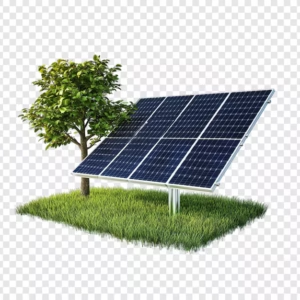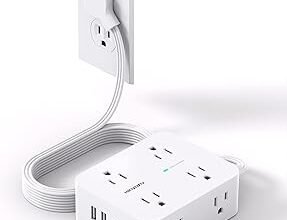Solar Cells: The Future of Clean and Renewable Energy
![Cells, modules, panels and systems [edit]](https://opentrendz.com/wp-content/uploads/2025/03/Cells-modules-panels-and-systems.jpg)
A solar cell, also known as a photovoltaic cell (PV cell), is an electronic device that converts the energy of light directly into electricity by means of the photovoltaic effect.[1] It is a type of photoelectric cell, a device whose electrical characteristics (such as current, voltage, or resistance) vary when it is exposed to light. Individual solar cell devices are often the electrical building blocks of photovoltaic modules, known colloquially as “solar panels”. Almost all commercial PV cells consist of crystalline silicon, with a market share of 95%. Cadmium telluride thin-film solar cells account for the remainder.[2] The common single-junction silicon solar cell can produce a maximum open-circuit voltage of approximately 0.5 to 0.6 volts.You know about solar cells and openrendz.
Vehicular applications
[edit]

Electric vehicles that operate off of solar energy and/or sunlight are commonly referred to as solar cars.[citation needed] These vehicles use solar panels to convert absorbed light into electrical energy to be used by electric motors, with any excess energy stored in batteries.[5] Batteries in solar-powered vehicles differ from starting batteries in standard ICE cars because they are fashioned to impart power towards electrical components of the vehicle for a long durations.[citation needed]
The first instance of photovoltaic cells within vehicular applications was around midway through the second half of the 1900s. In an effort to increase publicity and awareness in solar powered transportation Hans Tholstrup decided to set up the first edition of the World Solar Challenge in 1987.[citation needed] It was a 3000 km race across the Australian outback where competitors from industry research groups and top universities around the globe were invited to compete
Cells, modules, panels and systems
[edit]
![Cells, modules, panels and systems [edit]](https://opentrendz.com/wp-content/uploads/2025/03/Cells-modules-panels-and-systems-300x200.jpg)

Multiple solar cells in an integrated group, all oriented in one plane, constitute a solar photovoltaic panel or module. Photovoltaic modules often have a sheet of glass on the sun-facing side, allowing light to pass while protecting the semiconductor wafers. Solar cells connected in series creates an additive higher voltage.
Space
[edit]

Solar cells were first used in a prominent application when they were proposed and flown on the Vanguard satellite in 1958, as an alternative power source to the primary battery power source. By adding cells to the outside of the body, the mission time could be extended with no major changes to the spacecraft or its power systems. In 1959 the United States launched Explorer 6, featuring large wing-shaped solar arrays, which became a common feature in satellites. These arrays consisted of 9600 Hoffman solar cells.
By the 1960s, solar cells were (and still are) the main power source for most Earth orbiting satellites and a number of probes into the solar system, since they offered the best power-to-weight ratio. The success of the space solar power market drove the development of higher efficiencies in solar cells, due to limited other power options and the desire for the best possible cells, up until the National Science Foundation “Research Applied to National Needs” program began to push development of solar cells for terrestrial applications.
History
[edit]
The photovoltaic effect was experimentally demonstrated first by French physicist Edmond Becquerel. In 1839, at age 19, he built the world’s first photovoltaic cell in his father’s laboratory. Willoughby Smith first described the “Effect of Light on Selenium during the passage of an Electric Current” in a 20 February 1873 issue of Nature. In 1883 Charles Fritts built the first solid state photovoltaic cell by coating the semiconductor selenium with a thin layer of gold to form the junctions; the device was only around 1% efficient.[13] Other milestones include:
- 1888 – Russian physicist Aleksandr Stoletov built the first cell based on the outer photoelectric effect discovered by Heinrich Hertz in 1887.[14]
- 1904 – Julius Elster, together with Hans Friedrich Geitel, devised the first practical photoelectric cell.[15]
- 1905 – Albert Einstein proposed a new quantum theory of light and explained the photoelectric effect in a landmark paper, for which he received the Nobel Prize in Physics in 1921.[16]
Pricing and efficiency Improvements were gradual over the 1960s. One reason that costs remained high was because space users were willing to pay for the best possible cells, leaving no reason to invest in lower-cost, less-efficient solutions. Also, price was determined largely by the semiconductor industry; their move to integrated circuits in the 1960s led to the availability of larger boules at lower relative prices. As their price fell, the price of the resulting cells did as well. These effects lowered 1971 cell costs to some $100,000 per watt.[24]
In late 1969 Elliot Berman joined Exxon’s task force which was looking for projects 30 years in the future and in April 1973 he founded Solar Power Corporation (SPC), a wholly owned subsidiary of Exxon at that time.[25][26][27] The group concluded that electrical power would be much more expensive by 2000, and felt that the increase in price would make alternative energy sources more attractive. He conducted a market study and concluded that a price per watt of about $20/watt would create significant demand.[25] To reduce costs, the team
- eliminated the steps of polishing the wafers and coating them with an anti-reflective layer, by relying on rough-sawn wafer surfaces.
Research and industrial production post 1970’s
[edit]
Research into solar power for terrestrial applications became prominent with the U.S. National Science Foundation’s Advanced Solar Energy Research and Development Division within the “Research Applied to National Needs” program, which ran from 1969 to 1977,[29] and funded research on developing solar power for ground electrical power systems. A 1973 conference, the “Cherry Hill Conference“, set forth the technology goals required to achieve this goal and outlined an ambitious project for achieving them, kicking off an applied research program that would be ongoing for several decades.[30] The program was eventually taken over by the Energy Research and Development Administration (ERDA),[31] which was later merged into the U.S. Department of Energy.
Declining costs and exponential capacity growth
[edit]
Adjusting for inflation, it cost $96 per watt for a solar module in the mid-1970s. Process improvements and a very large boost in production have brought that figure down more than 99%, to 30¢ per watt in 2018 [35] and as low as 20¢ per watt in 2020. [36] Swanson’s law is an observation similar to Moore’s Law that states that solar cell prices fall 20% for every doubling of industry capacity. It was featured in an article in the British weekly newspaper The Economist in late 2012.[37] Balance of system costs are now higher than the solar panels alone, where in 2018 commercial arrays could be built at below $1.00 a watt, fully commissioned.[9]
Over decades, costs for solar cells and panels has declined for may reasons:
- Larger boules. When the semiconductor industry moved to ever-larger boules, older equipment became inexpensive.
- Larger physical solar cell size. Sizes grew as surplus semiconductor equipment became available. ARCO Solar’s original panels used cells 2 to 4 inches (50 to 100 mm) in diameter. Panels in the 1990s and early 2000s generally used 125 mm wafers; since 2008, almost all new panels use greater than 156mm cells,[38] and by 2020 even larger 182mm ‘M10’ cells.[39]
Solar-specific feed-in tariffs vary by and within country countries. Such tariffs can encourage the development of solar power projects and to achieve grid parity. Grid parity, the point at which photovoltaic electricity is equal to or cheaper than grid power without subsidies, is expected to be first achieved in areas with abundant sun and high electricity costs such as in California and Japan.[47] In 2007 BP claimed grid parity for Hawaii and other islands that otherwise use diesel fuel to produce electricity. George W. Bush set 2015 as the date for grid parity in the US.[48][49] The Photovoltaic Association reported in 2012 that Australia had reached grid parity (ignoring feed in tariffs).[50]
The price of solar panels fell steadily for 40 years, interrupted in 2004 when high subsidies in Germany drastically increased demand there and greatly increased the price of purified silicon (which is used in computer chips as well as solar panels). The recession of 2008 and the onset of Chinese manufacturing caused prices to resume their decline. In the four years after January 2008 prices for solar modules in Germany dropped from €3 to €1 per peak watt. During that same time production capacity surged with an annual growth of more than 50%. China increased solar panel production market share from 8% in 2008 to over 55% in the last quarter of 2010.[51] In December 2012 the price of Chinese solar panels had dropped to $0.60/Wp (crystalline modules).[52] (The abbreviation Wp stands for watt peak capacity, or the maximum capacity under optimal conditions.[53])
Theory
[edit]

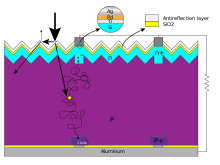
In operation, photons in sunlight hit the solar cell and are absorbed by the semiconductor. When the photons are absorbed, electrons are excited from the valence band to the conduction band (or from occupied to unoccupied molecular orbitals in the case of an organic solar cell), producing electron-hole pairs. If the electron-hole pairs are created near the junction between p-type and n-type materials the local electric field sweeps them apart to opposite electrodes, producing an excess of electrons on one side and an excess of holes on the other. When the solar cell is unconnected (or the external electrical load is very high) the electrons and holes will ultimately restore equilibrium by diffusing back across the junction against the field and recombine with each other giving off heat, but if the load is small enough then it is easier for equilibrium to be restored by the excess electrons going around the external circuit, doing useful work along the way.

Solar cell efficiency may be broken down into reflectance efficiency, thermodynamic efficiency, charge carrier separation efficiency and conductive efficiency. The overall efficiency is the product of these individual metrics.
The power conversion efficiency of a solar cell is a parameter which is defined by the fraction of incident power converted into electricity.[57]
A solar cell has a voltage dependent efficiency curve, temperature coefficients, and allowable shadow angles.

In 2014, three companies broke the record of 25.6% for a silicon solar cell. Panasonic’s was the most efficient. The company moved the front contacts to the rear of the panel, eliminating shaded areas. In addition they applied thin silicon films to the (high quality silicon) wafer’s front and back to eliminate defects at or near the wafer surface.[61]
In 2015, a 4-junction GaInP/GaAs//GaInAsP/GaInAs solar cell achieved a new laboratory record efficiency of 46.1% (concentration ratio of sunlight = 312) in a French-German collaboration between the Fraunhofer Institute for Solar Energy Systems (Fraunhofer ISE), CEA-LETI and SOITEC.[62]
In September 2015, Fraunhofer ISE announced the achievement of an efficiency above 20% for epitaxial wafer cells. The work on optimizing the atmospheric-pressure chemical vapor deposition (APCVD) in-line production chain was done in collaboration with NexWafe GmbH, a company spun off from Fraunhofer ISE to commercialize production.[63][64]
For triple-junction thin-film solar cells, the world record is 13.6%, set in June 2015.[65]

Solar cells are typically named after the semiconducting material of which they are composed. These materials have varying characteristics to absorb optimal available sunlight spectrum. Some cells are designed to handle sunlight that reaches the Earth’s surface, while others are optimized for use in space. Solar cells can be made of a single layer of light-absorbing material (single-junction) or use multiple physical configurations (multi-junctions) to take advantage of various absorption and charge separation mechanisms.
Solar cells can be classified into first, second and third generation:
- First generation cells—also called conventional, traditional or wafer-based cells—are made of crystalline silicon, the commercially predominant PV technology, that includes materials such as polysilicon and monocrystalline silicon.
Crystalline silicon
[edit]
By far, the most prevalent bulk material for solar cells is crystalline silicon (c-Si), also known as “solar grade silicon”.[71] Bulk silicon is separated into multiple categories according to crystallinity and crystal size in the resulting ingot, ribbon or wafer. These cells are entirely based around the concept of a p–n junction. Solar cells made of c-Si are made from wafers between 160 and 240 micrometers thick.
Monocrystalline silicon
[edit]

Monocrystalline silicon (mono-Si) solar cells feature a single-crystal composition that enables electrons to move more freely than in a multi-crystal configuration. Consequently, monocrystalline solar panels deliver a higher efficiency than their multicrystalline counterparts.[72] The corners of the cells look clipped, like an octagon, because the wafer material is cut from cylindrical ingots, that are typically grown by the Czochralski process. Solar panels using mono-Si cells display a distinctive pattern of small white diamonds.
Epitaxial silicon development
[edit]
Epitaxial wafers of crystalline silicon can be grown on a monocrystalline silicon “seed” wafer by chemical vapor deposition (CVD), and then detached as self-supporting wafers of some standard thickness (e.g., 250 μm) that can be manipulated by hand, and directly substituted for wafer cells cut from monocrystalline silicon ingots. Solar cells made with this “kerfless” technique can have efficiencies approaching those of wafer-cut cells, but at appreciably lower cost if the CVD can be done at atmospheric pressure in a high-throughput inline process.[63][64] The surface of epitaxial wafers may be textured to enhance light absorption.[73][74]
In June 2015, it was reported that heterojunction solar cells grown epitaxially on n-type monocrystalline silicon wafers had reached an efficiency of 22.5% over a total cell area of 243.4 cm2.[75]
Polycrystalline silicon, or multicrystalline silicon (multi-Si) cells are made from cast square ingots—large blocks of molten silicon carefully cooled and solidified. They consist of small crystals giving the material its typical metal flake effect. Polysilicon cells are the most common type used in photovoltaics and are less expensive, but also less efficient, than those made from monocrystalline silicon.
Ribbon silicon
[edit]
Ribbon silicon is a type of polycrystalline silicon—it is formed by drawing flat thin films from molten silicon and results in a polycrystalline structure. These cells are cheaper to make than multi-Si, due to a great reduction in silicon waste, as this approach does not require sawing from ingots.[76] However, they are also less efficient.
Mono-like-multi silicon (MLM)
[edit]
This form was developed in the 2000s and introduced commercially around 2009. Also called cast-mono, this design uses polycrystalline casting chambers with small “seeds” of mono material. The result is a bulk mono-like material that is polycrystalline around the outsides. When sliced for processing, the inner sections are high-efficiency mono-like cells (but square instead of “clipped”), while the outer edges are sold as conventional poly. This production method results in mono-like cells at poly-like prices.[77]
Thin film
[edit]
Thin-film technologies reduce the amount of active material in a cell. Most designs sandwich active material between two panes of glass. Since silicon solar panels only use one pane of glass, thin film panels are approximately twice as heavy as crystalline silicon panels, although they have a smaller ecological impact (determined from life cycle analysis).[78] [79]
Cadmium telluride
[edit]
Cadmium telluride is the only thin film material so far to rival crystalline silicon in cost/watt. However cadmium is highly toxic and tellurium (anion: “telluride”) supplies are limited. The cadmium present in the cells would be toxic if released. However, release is impossible during normal operation of the cells and is unlikely during fires in residential roofs.[80] A square meter of CdTe contains approximately the same amount of Cd as a single C cell nickel-cadmium battery, in a more stable and less soluble form.[80]
Copper indium gallium selenide
[edit]
Copper indium gallium selenide (CIGS) is a direct band gap material. It has the highest efficiency (~20%) among all commercially significant thin film materials (see CIGS solar cell). Traditional methods of fabrication involve vacuum processes including co-evaporation and sputtering. Recent developments at IBM and Nanosolar attempt to lower the cost by using non-vacuum solution processes.[81]
Silicon thin film
[edit]
Silicon thin-film cells are mainly deposited by chemical vapor deposition (typically plasma-enhanced, PE-CVD) from silane gas and hydrogen gas. Depending on the deposition parameters, this can yield amorphous silicon (a-Si or a-Si:H), protocrystalline silicon or nanocrystalline silicon (nc-Si or nc-Si:H), also called microcrystalline silicon.[82]
Amorphous silicon is the most well-developed thin film technology to-date. An amorphous silicon (a-Si) solar cell is made of non-crystalline or microcrystalline silicon. Amorphous silicon has a higher bandgap (1.7 eV) than crystalline silicon (c-Si) (1.1 eV), which means it absorbs the visible part of the solar spectrum more strongly than the higher power density infrared portion of the spectrum. The production of a-Si thin film solar cells uses glass as a substrate and deposits a very thin layer of silicon by plasma-enhanced chemical vapor deposition (PECVD).
Gallium arsenide thin film
[edit]
The semiconductor material gallium arsenide (GaAs) is also used for single-crystalline thin film solar cells. Although GaAs cells are very expensive[citation needed], they hold the world’s record in efficiency for a single-junction solar cell at 28.8%.[84] Typically fabricated on crystalline silicon wafer[85] with a 41% fill factor, by moving to porous silicon fill factor can be increased to 56% with potentially reduced cost. Using less active GaAs material by fabricating nanowires is another potential pathway to cost reduction.[86] GaAs is more commonly used in multijunction photovoltaic cells for concentrated photovoltaics (CPV, HCPV) and for solar panels on spacecraft, as the industry favours efficiency over cost for space-based solar power. Based on the previous literature and some theoretical analysis, there are several reasons why GaAs has such high power conversion efficiency for three main reasons:
Multijunction cells
[edit]
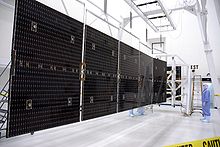
Multi-junction cells consist of multiple thin films, each essentially a solar cell grown on top of another, typically using metalorganic vapour phase epitaxy. Each layer has a different band gap energy to allow it to absorb electromagnetic radiation over a different portion of the spectrum. Multi-junction cells were originally developed for special applications such as satellites and space exploration, but are now used increasingly in terrestrial concentrator photovoltaics (CPV), an emerging technology that uses lenses and curved mirrors to concentrate sunlight onto small, highly efficient multi-junction solar cells. By concentrating sunlight up to a thousand times, High concentration photovoltaics (HCPV) has the potential to outcompete conventional solar PV in the future.[87]: 21, 26
GaInP/Si dual-junction solar cells
[edit]
In 2016, a new approach was described for producing hybrid photovoltaic wafers combining the high efficiency of III-V multi-junction solar cells with the economies and wealth of experience associated with silicon. The technical complications involved in growing the III-V material on silicon at the required high temperatures, a subject of study for some 30 years, are avoided by epitaxial growth of silicon on GaAs at low temperature by plasma-enhanced chemical vapor deposition (PECVD).[93]
Si single-junction solar cells have been widely studied for decades and are reaching their practical efficiency of ~26% under 1-sun conditions.[94] Increasing this efficiency may require adding more cells with bandgap energy larger than 1.1 eV to the Si cell, allowing to convert short-wavelength photons for generation of additional voltage.
Research in solar cells
[edit]
Perovskite solar cells
[edit]
Perovskite solar cells are solar cells that include a perovskite-structured material as the active layer. Most commonly, this is a solution-processed hybrid organic-inorganic tin or lead halide based material. Efficiencies have increased from below 5% at their first usage in 2009 to 25.5% in 2020, making them a very rapidly advancing technology and a hot topic in the solar cell field.[98] Researchers at University of Rochester reported in 2023 that significant further improvements in cell efficiency can be achieved by utilizing Purcell effect.[99]
Perovskite solar cells are also forecast to be extremely cheap to scale up, making them a very attractive option for commercialisation. So far most types of perovskite solar cells have not reached sufficient operational stability to be commercialised, although many research groups are investigating ways to solve this.
Bifacial solar cells
[edit]

With a transparent rear side, bifacial solar cells can absorb light from both the front and rear sides. Hence, they can produce more electricity than conventional monofacial solar cells. The first patent of bifacial solar cells was filed by Japanese researcher Hiroshi Mori, in 1966.[106] Later, it is said that Russia was the first to deploy bifacial solar cells in their space program in the 1970s.[citation needed] In 1976.
Intermediate band
[edit]
Intermediate band photovoltaics in solar cell research provides methods for exceeding the Shockley–Queisser limit on the efficiency of a cell. It introduces an intermediate band (IB) energy level in between the valence and conduction bands. Theoretically, introducing an IB allows two photons with energy less than the bandgap to excite an electron from the valence band to the conduction band. This increases the induced photocurrent and thereby efficiency.[116]
Luque and Marti first derived a theoretical limit for an IB device with one midgap energy level using detailed balance. They assumed no carriers were collected at the IB and that the device was under full concentration.
Upconversion and downconversion
[edit]
Photon upconversion is the process of using two low-energy (e.g., infrared) photons to produce one higher energy photon; downconversion is the process of using one high energy photon (e.g., ultraviolet) to produce two lower energy photons. Either of these techniques could be used to produce higher efficiency solar cells by allowing solar photons to be more efficiently used. The difficulty, however, is that the conversion efficiency of existing phosphors exhibiting up- or down-conversion is low, and is typically narrow band.
One upconversion technique is to incorporate lanthanide-doped materials (Er3+
, Yb3+
, Ho3+
Light-absorbing dyes
Dye-sensitized solar cells (DSSCs) are made of low-cost materials and do not need elaborate manufacturing equipment, so they can be made in a DIY fashion. In bulk it should be significantly less expensive than older solid-state cell designs. DSSC’s can be engineered into flexible sheets and although its conversion efficiency is less than the best thin film cells, its price/performance ratio may be high enough to allow them to compete with fossil fuel electrical generation.
Quantum dots
[edit]
Quantum dot solar cells (QDSCs) are based on the Gratzel cell, or dye-sensitized solar cell architecture, but employ low band gap semiconductor nanoparticles, fabricated with crystallite sizes small enough to form quantum dots (such as CdS, CdSe, Sb
2S
3, PbS, etc.), instead of organic or organometallic dyes as light absorbers. Due to the toxicity associated with Cd and Pb based compounds there are also a series of “green” QD sensitizing materials in development (such as CuInS2, CuInSe2 and CuInSeS).[124] QD’s size quantization allows for the band gap to be tuned by simply changing particle size. They also have high extinction coefficients and have shown the possibility of multiple exciton generation.[125]
Organic/polymer solar cells
[edit]
Organic solar cells and polymer solar cells are built from thin films (typically 100 nm) of organic semiconductors including polymers, such as polyphenylene vinylene and small-molecule compounds like copper phthalocyanine (a blue or green organic pigment) and carbon fullerenes and fullerene derivatives such as PCBM.
They can be processed from liquid solution, offering the possibility of a simple roll-to-roll printing process, potentially leading to inexpensive, large-scale production. In addition, these cells could be beneficial for some applications where mechanical flexibility and disposability are important. Current cell efficiencies are, however, very low, and practical devices are essentially non-existent.
Energy conversion efficiencies achieved to date using conductive polymers are very low compared to inorganic materials. However, Konarka Power Plastic reached efficiency of 8.3%[134] and organic tandem cells in 2012 reached 11.1%.[citation needed]
Adaptive cells
[edit]
Adaptive cells change their absorption/reflection characteristics depending on environmental conditions. An adaptive material responds to the intensity and angle of incident light. At the part of the cell where the light is most intense, the cell surface changes from reflective to adaptive, allowing the light to penetrate the cell. The other parts of the cell remain reflective increasing the retention of the absorbed light within the cell.[143]
In 2014, a system was developed that combined an adaptive surface with a glass substrate that redirect the absorbed to a light absorber on the edges of the sheet. The system also includes an array of fixed lenses/mirrors to concentrate light onto the adaptive surface. As the day continues, the concentrated light moves along the surface of the cell. That surface switches from reflective to adaptive when the light is most concentrated and back to reflective after the light moves along.[143]
Surface texturing
[edit]

Incident light rays onto a textured surface do not reflect out to the air as opposed to rays onto a flat surface, but rather some light rays are bounced back onto the other surface again due to the geometry of the surface; increasing light absorption and light to electricity conversion efficiency. Surface texturing is one technique used to reduce optical losses, primarily in cost-effective, low light absorption thin-film solar cells. In combination with anti-reflective coating, surface texturing technique can effectively trap light rays within a thin film silicon solar cell. Consequently, at the same power output, thickness for solar cells can decrease with the increased absorption of light rays.
Encapsulation
[edit]
Solar cells are commonly encapsulated in a transparent polymeric resin to protect the delicate solar cell regions for coming into contact with moisture, dirt, ice, and other environmental conditions expected during operation. Encapsulants are commonly made from polyvinyl acetate or glass. Most encapsulants are uniform in structure and composition.
Manufacture
[edit]
|
This section needs additional citations for verification. (June 2014)
|

Solar cells share some of the same processing and manufacturing techniques as other semiconductor devices. However, the strict requirements for cleanliness and quality control of semiconductor fabrication are more relaxed for solar cells, lowering costs.
Polycrystalline silicon wafers are made by wire-sawing block-cast silicon ingots into 180 to 350 micrometer thick wafers. The wafers are usually lightly p-type-doped. A surface diffusion of n-type dopants is performed on the front side of the wafer. This forms a p–n junction a few hundred nanometers below the surface.
Manufacturers and certification
[edit]
|
|
This section needs to be updated. (November 2021)
|
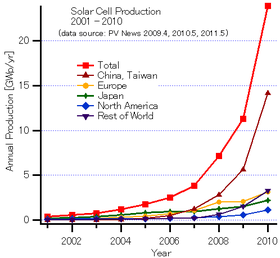
National Renewable Energy Laboratory tests and validates solar technologies. Three reliable groups certify solar equipment: UL and IEEE (both U.S. standards) and IEC[citation needed].
The IEA‘s 2022 Special Report highlights China’s dominance over the solar PV supply chain, with an investment exceeding US$50 billion and the creation of around 300,000 jobs since 2011. China commands over 80% of all manufacturing stages for solar panels. This control has drastically cut costs but also led to issues like supply-demand imbalances and polysilicon production constraints. Nevertheless, China’s strategic policies have reduced solar PV costs by more than 80%, increasing global affordability. In 2021, China’s solar PV exports were over US$30 billion.[166]
China
[edit]
As of September 2018, sixty percent of the world’s solar photovoltaic modules were made in China.[167] As of May 2018, the largest photovoltaic plant in the world is located in the Tengger desert in China.[168] In 2018, China added more photovoltaic installed capacity (in GW) than the next 9 countries combined.[169] In 2021, China’s share of solar PV module production reached approximately 70%.[166]
In the first half of 2023, China’s production of PV modules exceeded 220 GW, marking an increase of over 62% compared to the same period in 2022. In 2022, China maintained its position as the world’s largest PV module producer, holding a dominant market share of 77.8%.[170]
Vietnam
[edit]
In 2022, Vietnam was the second-largest PV module producer, only behind China, with its production capacity rising to 24.1 GW, marking a significant 47% increase from the 16.4 GW produced in 2021. Vietnam accounts for 6.4% of the world’s photovoltaic production.[170]
Malaysia
[edit]
In 2022, Malaysia was the third-largest PV module producer, with a production capacity of 10.8 GW, accounting for 2.8% of global production. This placed it behind China, which dominated with 77.8%, and Vietnam, which contributed 6.4%.[170]
United States
[edit]
Solar energy production in the U.S. has doubled from 2013 to 2019.[171] This was driven first by the falling price of quality silicon,[172][173][174] and later simply by the globally plunging cost of photovoltaic modules.[168][175] In 2018, the U.S. added 10.8GW of installed solar photovoltaic energy, an increase of 21%.[169]
Latin America: Latin America has emerged as a promising region for solar energy development in recent years, with over 10 GW of installations in 2020. The solar market in Latin America has been driven by abundant solar resources, falling costs, competitive auctions and growing electricity demand. Some of the leading countries for solar energy in Latin America are Brazil, Mexico, Chile and Argentina. However, the solar market in Latin America also faces some challenges, such as political instability, financing gaps and power transmission bottlenecks.[citation needed]
Materials sourcing
[edit]
|
This section needs expansion. You can help by adding to it. (November 2021)
|
Like many other energy generation technologies, the manufacture of solar cells, especially its rapid expansion, has many environmental and supply-chain implications. Global mining may adapt and potentially expand for sourcing the needed minerals which vary per type of solar cell.[177][178] Recycling solar panels could be a source for materials that would otherwise need to be mined.[46]
Disposal
[edit]
Solar cells degrade over time and lose their efficiency. Solar cells in extreme climates, such as desert or polar, are more prone to degradation due to exposure to harsh UV light and snow loads respectively.[179] Usually, solar panels are given a lifespan of 25–30 years before decommissioning.[180]
The International Renewable Energy Agency estimated that the amount of solar panel electronic waste generated in 2016 was 43,500–250,000 metric tons. This number is estimated to increase substantially by 2030, reaching an estimated waste volume of 60–78 million metric tons in 2050.[181]
Recycling
[edit]
The most widely used solar cells in the market are crystalline solar cells. A product is truly recyclable if it can harvested again. In the 2016 Paris Agreement, 195 countries agreed to reduce their carbon emissions by shifting their focus away from fossil fuels and towards renewable energy sources. Owing to this, Solar will be a major contributor to electricity generation all over the world. So, there will be a plethora of solar panels to be recycled after the end of their life cycle. In fact, many researchers around the globe have voiced their concern about finding ways to use silicon cells after recycling.[182][183][184][185]
Additionally, these cells have hazardous elements/compounds, including lead (Pb), cadmium (Cd) or cadmium sulfide (CdS), selenium (Se), and barium (Ba) as dopants aside from the valuables silicon (Si), aluminum (Al), silver (Ag), and copper (Cu). The harmful elements/compounds if not disposed of with the proper technique can have severe harmful effects on human life and wildlife alike.[186]
See also
[edit]
- Anomalous photovoltaic effect
- Autonomous building
- Black silicon
- Electromotive force (Solar cell)
- Energy development
- Sustainable development
- Flexible substrate
- Green technology
- Hot spot (photovoltaics)
- Inkjet solar cell
- List of types of solar cells
- List of solar engines
- Metallurgical grade silicon
- Microgeneration
- Nanoflake
References
[edit]
- ^ Solar Cells. chemistryexplained.com
- ^ Special Report on Solar PV Global Supply Chains (PDF). International Energy Agency. August 2022.
- ^ “Solar cells – performance and →use”. solarbotic s.net.
- ^ Al-Ezzi, Athil S.; Ansari, Mohamed Nainar M. (8 July 2022). “Photovoltaic Solar Cells: A Review”. Applied System Innovation. 5 (4): 67. doi:10.3390/asi5040067. ISSN 2571-5577.
- ^ Arulious, Jora A; Earlina, D; Harish, D; Sakthi Priya, P; Inba Rexy, A; Nancy Mary, J S (1 November 2021). “Design of solar powered electric vehicle”. Journal of Physics: Conference Series. 2070 (1): 012105. Bibcode:2021JPhCS2070a2105A. doi:10.1088/1742-6596/2070/1/012105. ISSN 1742-6588.
- ^ Connors, John (21–23 May 2007). “On the Subject of Solar Vehicles and the Benefits of the Technology”. 2007 International Conference on Clean Electrical Power. Capri, Italy. pp. 700–705. doi:10.1109/ICCEP.2007.384287.
Bibliography
[edit]
- Perlin, John (1999). From space to Earth: the story of solar electricity. Earthscan. p. 50. ISBN 978-0-937948-14-9.
External links
[edit]
- PV Lighthouse Calculators and Resources for photovoltaic scientists and engineers
- Photovoltaics CDROM online Archived 15 April 2014 at the Wayback Machine
- Solar cell manufacturing techniques
- Solar Energy Laboratory at University of Southampton
- NASA’s Photovoltaic Info
- Green, M. A.; Emery, K.; Hishikawa, Y.; Warta, W. (2010). “Solar cell efficiency tables (version 36)”. Progress in Photovoltaics: Research and Applications. 18 (5): 346. doi:10.1002/pip.1021.W. doi:10.1088/2515-7655/ab2338. hdl:10044/1/70500. S2CID 250871748.
![Cells, modules, panels and systems [edit]](https://opentrendz.com/wp-content/uploads/2025/03/Vehicular-applications6-300x300.avif)
